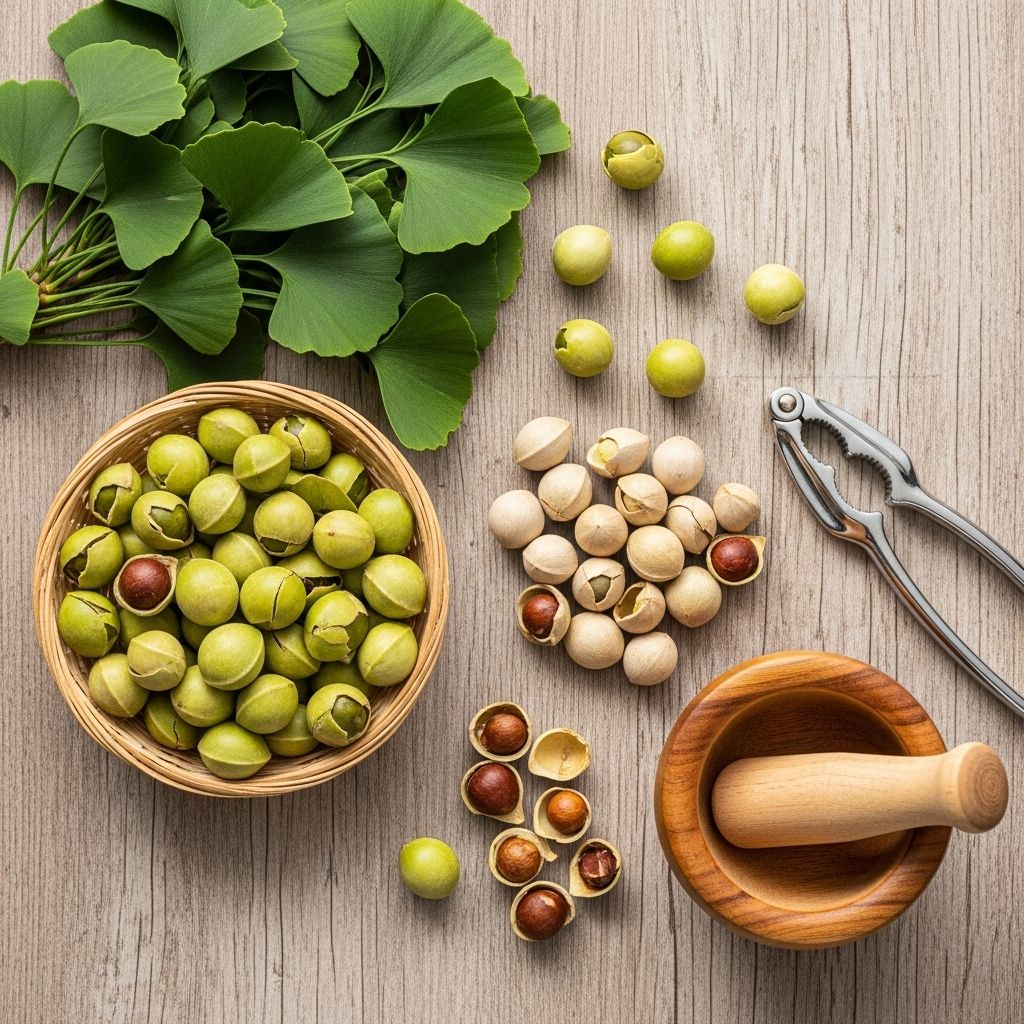Ginkgo Nuts: Essential Urban Foraging Guide & Expert Tips
Discover the hidden culinary treasure within the malodorous fruits of urban ginkgo trees

Image: HearthJunction Design Team
Discovering Ginkgo Nuts: An Urban Foraging Treasure
In the crisp days of mid-autumn, as vibrant yellow leaves carpet city sidewalks, an ancient culinary treasure quietly presents itself to urban foragers. Female ginkgo trees, scattered throughout cities worldwide, offer a bounty that many pedestrians hurriedly step over, unaware of the delicacy hidden within the malodorous fruits. While most urbanites wrinkle their noses at the unmistakable smell of fallen ginkgo fruits, knowledgeable foragers recognize this seasonal opportunity to harvest one of nature’s oldest edible offerings.
Ginkgo nuts, encased in fleshy, odiferous fruits, represent a culinary tradition dating back thousands of years. These pistachio-green kernels, with their unique flavor profile somewhere between roasted chestnuts and mild tofu, provide not just sustenance but a direct connection to the prehistoric world. For the adventurous urban forager willing to brave the smell and employ careful preparation techniques, ginkgo nuts offer a remarkable seasonal treat with ties to ancient culinary traditions.
Understanding the Living Fossil: Ginkgo biloba
Before delving into harvesting techniques, it’s important to understand the extraordinary tree that produces these edible treasures. Ginkgo biloba stands alone as the only species in its genus, family, order, and even division. This botanical uniqueness reflects its status as a living fossil, with a lineage stretching back over 200 million years. The ginkgo tree witnessed the rise and fall of dinosaurs, surviving virtually unchanged through major extinction events that reshaped our planet’s biodiversity.
While ginkgo trees are rare in the wild (primarily remaining in certain regions of China), they have been widely planted around the globe for ornamental purposes. Their resilience makes them ideal urban specimens – they tolerate pollution, resist pests and diseases, and display spectacular autumn color. For city planning purposes, male trees are typically preferred since they produce no fruit (and consequently, no smell). However, female trees inevitably find their way into urban landscapes, either through misidentification at planting time or through natural processes.
The distinctive fan-shaped leaves with parallel veins running to their edges make ginkgos easily identifiable even before their spectacular autumn display. These leaves, while not the focus of our culinary exploration, are themselves harvested for medicinal purposes, particularly for memory-enhancing supplements.
Identifying and Harvesting Ginkgo Fruits
The first step in harvesting ginkgo nuts is locating female trees, which is remarkably simple during fruiting season in mid-autumn. Follow your nose – the unmistakable odor of ripe ginkgo fruits has been variously described as resembling rancid butter, vomit, or dog excrement. While unpleasant, this smell is your guide to potential harvest locations.
Female ginkgo trees produce abundant crops of small, round fruits approximately the size of ping pong balls. These fruits have a fleshy, orange-yellow outer layer that softens as it ripens before falling to the ground beneath the tree. The best harvesting strategy is to collect the fruits shortly after they’ve fallen, when they’re still relatively intact.
When harvesting, consider the following tips:
- Wear disposable gloves to protect your hands from the smelly pulp
- Bring sealed plastic bags to contain both the odor and mess
- Focus on fruits that have recently fallen rather than those that have been on the ground for days
- Be respectful of public spaces and leave no trace of your harvesting activities
Processing Ginkgo Fruits: From Stink to Delicacy
Once you’ve collected your ginkgo fruits, the next step is processing them to extract the valuable kernels inside. This procedure requires several steps to transform the malodorous fruits into clean, cookable ginkgo nuts.
Step 1: Removing the Pulp
The most challenging aspect of processing ginkgo fruits is removing the fleshy, odorous outer pulp. This is best done outdoors while still wearing gloves. There are several effective approaches:
- Gently roll fruits under your foot on a surface that can be easily cleaned
- Soak fruits in water and carefully remove the softened pulp
- Use a coarse brush under running water to separate the pulp from the inner shell
The goal is to reveal the cream-colored, thin-shelled kernel within, which resembles a small pistachio or sunflower seed in its shell. Thoroughly rinse these shells to remove any remaining pulp residue.
Step 2: Opening the Shells
The thin shells protecting the ginkgo kernels can be cracked using light pressure. Unlike harder nuts requiring specialized tools, ginkgo shells can often be opened by:
- Applying gentle pressure with your fingers
- Using the flat side of a knife to crack them open
- Employing a light tap with a small hammer
Inside the shell, you’ll find the prized ginkgo kernel – a distinctively pistachio-green seed approximately 3/4-inch long. These kernels contain the culinary treasure you’ve been working toward.
Cooking and Enjoying Ginkgo Nuts
Ginkgo nuts should never be consumed raw. Traditional wisdom cautions against overconsumption, with recommendations limiting intake to between 10-30 nuts in a single sitting. This precaution stems from the presence of certain compounds in the nuts that can cause digestive discomfort or allergic reactions in some individuals if eaten in excess.
Basic Skillet-Roasting Method
The simplest and most traditional preparation method is skillet-roasting, which enhances the nuts’ flavor and texture while ensuring they’re safe to eat. Here’s how to prepare them:
- Heat a dry skillet or pan over medium heat
- Add the shelled ginkgo kernels to the hot pan
- Stir or shake the pan continuously to prevent burning
- Roast until the kernels develop light brown spots and become slightly puffy, usually 5-10 minutes
- Remove from heat and lightly salt if desired
The resulting nuts have a unique texture and flavor – slightly chewy with a subtle sweetness reminiscent of chestnuts but with their own distinctive character. They’re best enjoyed warm, immediately after roasting.
Culinary Uses and Pairings
While delicious on their own as a simple snack, ginkgo nuts also have a place in more elaborate culinary applications:
- Added to rice dishes for texture and nutritional value
- Incorporated into traditional Asian soups and congee
- Used as garnish for salads or vegetable dishes
- Paired with other seasonal autumn ingredients like mushrooms
In East Asian cuisine, particularly Japanese, Chinese, and Korean cooking, ginkgo nuts have been prized for centuries not just for their flavor but also for their aesthetic appeal – the vibrant green color adds visual interest to many dishes.
Storage Options
If you’ve harvested more ginkgo nuts than you can consume immediately, you have several storage options:
Fresh ginkgo kernels in their shells can be refrigerated for up to two weeks. For longer preservation, the shelled kernels can be frozen. Simply spread them on a baking sheet, freeze until solid, then transfer to freezer bags or containers. Frozen ginkgo seeds will retain their quality for several months.
To revive frozen ginkgo seeds, allow them to thaw for approximately 20 minutes, then skillet-roast them following the standard method. Remarkably, they retain their lovely green color and are best enjoyed warm after roasting.
Cultural Significance and Nutritional Value
Ginkgo nuts have been part of East Asian cuisine and traditional medicine for thousands of years. In China, where wild ginkgo trees still grow, the nuts are considered both a delicacy and a health food, often incorporated into special occasion dishes and seasonal celebrations.
Nutritionally, ginkgo nuts provide a good source of:
- Complex carbohydrates
- Protein
- Essential minerals including potassium and phosphorus
- Various antioxidants
While the leaves of the ginkgo tree are more commonly associated with medicinal properties (particularly for cognitive function), the nuts themselves have traditionally been used in Chinese medicine for respiratory conditions and digestive health.
Foraging Ethics and Considerations
As with any foraging activity, ethical considerations should guide your ginkgo nut harvesting:
- Always be certain of tree identification before harvesting
- Respect public and private property boundaries
- Take only what you will reasonably use
- Leave no trace of your harvesting activities
- Consider sharing your knowledge and harvest with interested community members
Urban foraging creates connections between city dwellers and the natural world, even in highly developed environments. The ginkgo tree, with its ancient lineage and modern urban presence, offers a particularly poignant example of how nature continues to provide sustenance in unexpected places.
Frequently Asked Questions
Q: Are ginkgo nuts safe to eat?
A: Yes, ginkgo nuts are safe to eat when properly prepared through cooking methods like roasting. However, they should never be consumed raw, and traditional wisdom recommends limiting consumption to 10-30 nuts per sitting.
Q: How can I tell male and female ginkgo trees apart?
A: When not fruiting, male and female ginkgo trees are difficult to distinguish. The easiest identification occurs in autumn when female trees produce their distinctive smelly fruits, while male trees drop only leaves.
Q: When is the best time to harvest ginkgo nuts?
A: Mid-autumn (typically October to November in the Northern Hemisphere) is the optimal harvesting time, when the fruits ripen and fall from the trees.
Q: Can I grow my own ginkgo tree for nuts?
A: Yes, but you’ll need a female tree for fruit production, which many neighbors might object to due to the smell. Additionally, ginkgo trees can take 20+ years to begin producing fruit, making this a long-term investment.
Q: Are there any look-alike species I should be concerned about when foraging?
A: Ginkgo trees are very distinctive with their fan-shaped leaves and unique growth pattern. There are no dangerous look-alikes, making them one of the safer trees for beginning foragers to identify.
References
- https://www.gardenista.com/posts/ginkgo-nuts/
- https://www.gardenista.com/posts/trend-alert-the-unexpected-elegance-of-ginkgo/
- https://www.gardenista.com/posts/forage-fall-easy-edibles/
- https://www.phillyorchards.org/2020/11/19/spotlight-on-ginkgo-pretty-edible-historic/
- https://www.motherearthnews.com/real-food/foraging-for-ginkgo-nuts-zbcz1409/
Read full bio of Shinta












